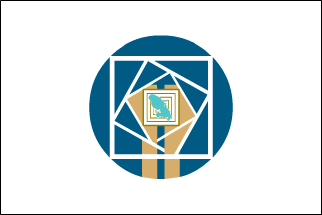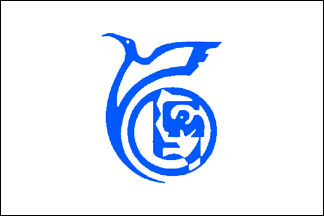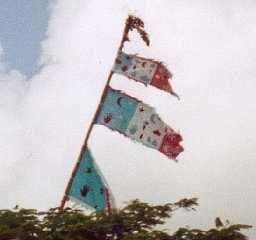![[Flag of France]](../images/f/fr.gif)
Official flag
by Mark Sensen

Last modified: 2003-09-13 by dov gutterman
Keywords: martinique | france | st. lucia | cross | snake | carribeans |
Links: FOTW homepage |
search |
disclaimer and copyright |
write us |
mirrors
Official Name: Department of Martinique
(Departement de la Martinique)
Capital: Fort-de-France
Location: Caribbean
Government Type: Overseas Department of France
ISO Code: MQ
See also:
Guadeloupe, Martinique, Guyane and Reunion, the 4 french
"DOM" (departement d'outre-mer - over-seas department)
are each both a departement and a region : so, they are 4 regions
made of only one departement. Regions and departements having
precise and different parts to play in the french system, the 4
DOMs have both a regional and a general council.
Olivier Touzeau, 31 December 2001
The official flag is the French one, but there is a banner of
the arms: a blue field with a white cross, and in each canton a
white snake in the form of an 'L'. I don't know if this is
official, but it appears in Hesmer's book. Devereux's book [dev94] says it flies only with the
French Tricolour. It was the flag for the former French colony of
Saint-Lucia/Martinique. The "L" snakes which appear in
the arms and flag recall the "L" of Lucia, although
this flag never flew on that island. The proportions are 2:3.
Pascal Vagnat, 13 March 1996
The snakes are in the shape of a stylised "L", a bit
like the British pound sign. The L means "Lucia"
because Martinique was administered from St. Lucia before the
British took that island. The flag is therefore quite old - it
pre-dates the French Revolution. The white cross on blue can also
be seen in the flag of Quebec, and is in fact France's
traditional national cross - equivalent to England's red cross on
white.
Roy Stilling, 6 July 1996
The flag of Martinique (white cross on blue with four snakes)
is given as a flag which is used since 1766. That flag was
introduced by law of 4 August 1766 "for all the ships of the
[French] colonies of Martinique and St. Lucia". It was a
French flag and was surely abolished when the British took over
those colonies.
Ralf Stelter, 27 June 1999
The unofficial Martinique flag is not especially associated
with aspiration to independence. Independentist
movements use totally different flags. Anyway, the snake
flag, often improperly considered as the departmental flag of
Martinique, was once official.
In Vexillacta #9 (September 2000), L. Nyssen adds some
interesting information to what is already mentioned about the
snake flag. The snake flag is considered locally as a 'blazon',
and is not available locally as a flag. It is mainly erroneously
used as a courtesy ensign by yachtmen, which should hoist the
Tricolore civil ensign. Pascal Vagnat quoted Devereux saying that
the Martinique flag was always associated with the French
Tricolore, but I guess this is a confusion or an erroneous
generalization of the status of the French Polynesia flag (which
is official and prescribed in association with the French
Tricolore).
The snake flag was adopted as an ensign in 1766, and was nothing
but a variant of the civil ensign used by French vessels.
According to an edict by Colbert (1689, quoting a previous edict
of 1661), merchant vessels should hoist a blue ensign with a
white cross. Such ensigns were also used in the French ports.
When a civil ensign was used in a colony, a distinctive emblem
was added in each of the four blue quarters (example: the
fleur-de-lys for the ensign of Nouvelle-France, the current flag
of Quebec). The snake used for Martinique and St. Lucia is a
venomous snake related to the rattlesnake, the 'trigonocephale',
very common in the sugar cane and banana plantations. Since the
ensign is a banner of arms, the particular design of the snake is
not specified. The snake has a triangular head (as its name says
it in Ancient Greek) and a forked tongue. In the drawing shown
beside the original text translated below, the artist
misinterpreted the snake name and gave it a triangular tongue.
According to this drawing, the relation between the snake shape
and the L of (St.) Lucia seems very dubious. Most 'blazons' seen
on stickers and postcards show the 'standard' snake drawn by
Pierre Gay, . A L-shaped snake is shown in the last release of
the tourism guide Michelin Guadeloupe - Martinique - Petites
Antilles.
L. Nyssen gives the text of the original edict setting the
Martinique and St. Lucia ensign. His original source is Code de
la Martinique, new edition by Durand Molaro, Saint-Pierre, 1807,
volume 2, p. 487. The book was consulted at the Schoelcher
library in Fort-de-France. My translation follows:
N° 359. - Edict of Messrs. the General and the Intendant, which
requires any captain or owner of vessels, ships, schooners and
boats of Martinique and St. Lucia to hoist a distinctive ensign
[and which] set the ensign of these two Colonies. From 4 August
1766.
"Since all places of the Kingdom and the Colony of St.
Domingue have each of them a specific and distinctive ensign, so
that one can identify from a distance to which harbours or
countries belong the vessels which would like to enter any
harbour or port of the French Colonies or approach the coasts, We
found necessary to set an ensign for the Colonies of Martinique
and St. Lucia, which shall be described below. We, [etc...] rule
on and prescribe the following:
Article 1.
Any owner of vessels, ships, schooners and boats, depending on
the Government of Martinique and St. Lucia, shall equip their
vessels with a blue ensign with a white cross which shall quarter
the ensign ; in each quarter, and in the middle of it, a white
snake will be figured, so that there will be four white snakes in
the ensign, which shall be recognized as the ensign of Martinique
and St. Lucia.
Article 2.
When captains or owner enter the ports and harbours, or reach the
coasts of this Government, any other French Colony, or the
Kingdom of France, they shall prescribe to hoist the ensign
described above, so that they will be recognized as vessels from
Martinique and St. Lucia, and they shall hoist it the same way
the captains of the other ports of the Kingdom hoist their
ensign.
Article 3.
Any owner of a vessel who, within the alloted time ofthree months
after the release of the present edict, will not have equiped
himself with the ensign described above, shall be fined 300
pounds, to be allocated to the repairing of the Port of
Fort-Royal [now Fort-de-France].
Article 4.
Any captain or owner who shall not conform to the present edict
and not hoist the distinctive ensign of the two Colonies when he
approaches the coasts shall be fined 100 pounds, to be allocated
as described above.
[We] command the Admiralties of this Government to register the
present edict [...]
Given to Martinique on 4 August 1766.
Signed: d'Ennery and the President de Peinier."
Ivan Sache, 28 September 2000
I was lucky enough to have a honeymoon in september in
Martinique. The unofficial flag for Martinique, as far as I can
say, rather rarely seen on the island. In fact, in spite of
having always been looking for it, I saw it only once : in
Saint-Pierre, the city which was destroyed in 1902 by the
Montagne Pele'e, near the museum of the eruption. It was flown
near France, European Union, Canada, and United States flags.
Olivier Touzeau, 20 November 2001

by Pascal Vagnat, 30 December 2001
As every french de'partment d'outre-mer, Martinique is at the
same time a r'egion and a d'epartement, and has both a general
[de'partement] and a regional [region] council. The flag of the
general council is easy to see when you are in Fort-de-France. It
is flown proudly on the building of the general council, and look
like we have above: logo on white field, no text.
Olivier Touzeau, 20 November 2001

by Pascal Vagnat, 22 November 2001
I tried to see too the flag of the regional council. But I
even could not find the building of the regional council. After
two hours of driving in the same sector where it was supposed to
be, I was forced to give up my flag-hunting. It is supposed to be
the logo on white. The logo can be seen at <www.cr-martinique.fr>.
Olivier Touzeau, 20 November 2001
Pascal Vagnat sent me the image of the supposed flag
of the regional council. A thumbnail of such a flag can be
spotted on a flagmaker's site, at <www.eco-drapeaux.com>
(website now unreachable). Unconfirmed!!!
Olivier Touzeau, 22 November 2001
Description and symbolism of the logo according to the
regional council website at <www.cr-martinique.fr>:
"For a territorial collectivity, it is a system of graphic
identification. For this purpose, it must be the meeting point
between a region, its history, its elected and their projects,
its habitants and their expectations.
It is a sign bearing several values; it also represents a
consensus and the adhesion of various personalities to a same
signature.
It means the total cohesion into a global action of
communication.
The bird, with a long beak, could be assimilated to a colibri,
traduces the idea of dynamism, of flight, of take-off, of
impetus. It symbolises the leads by the assembly that is in
charge of the economical development of Martinique.
This bird seems to be propelled by a kind of spiral. Inside of
it, Martinique, stylised, with the letters C R M : Conseil
Regional of Martinique.
The circle symbolises fullness, strength and balance."
Pascal Gross, 22 November 2001

by Olivier Touzeau, 20 November 2001
Here is a UFE seen in Sainte-Marie, on the road to the museum
of banana. I saw those tricolore flags with muslim emblems flown
near a rather isolated house. I suppose the house belongs to
someone who fought during french decolonization in Northern
Africa, but I may be wrong. There was nobody there, so I could
not ask any question about that. Any other hypothesis?
Olivier Touzeau, 20 November 2001